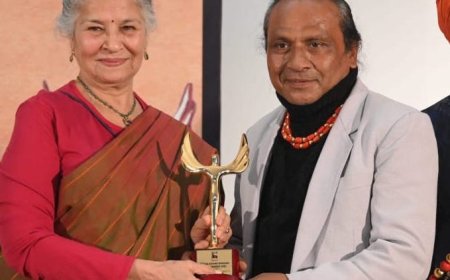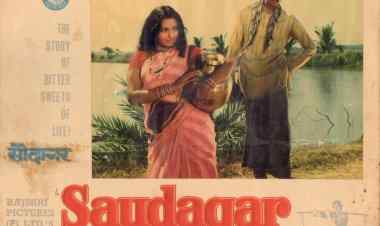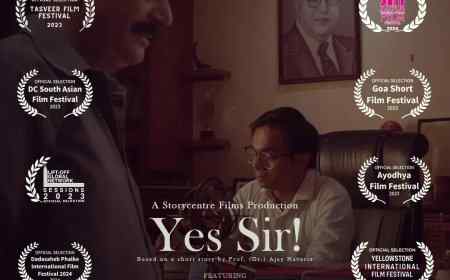THE REAL PICTURE BEHIND THE “COW HUG DAY” AND THE FILM THE PLASTIC COW

Indian film scholar, Dr. Shoma A. Chatterji writes that the cow till this day is regarded to be a symbol of wealth and prosperity and this has been current since Vedic times. She is considered to be a benign and maternal figure, the gau mata.
Very recently, the Government at the centre with its obsession for Hinduism which considers the cow as a holy animal, had announced that the Valentine’s Day would be replaced with the “Cow Hugging Day” because the nationalist government believes that Western culture threatens Indian traditions and considers “Valentine’s Day” a very Western practice that does not lend itself to the Indian (read Hindu) culture and tradition. In a statement last week, the country’s government-run animal welfare department announced that “Cow Hug Day,” a new celebration of India’s traditions, would take place on February 14.
The appeal read, “Vedic traditions are almost on the verge of extinction due to the progress of [Western] culture,” adding “the dazzle of Western civilization has made our physical culture and heritage almost forgotten.” However, a couple of days before D-day, the Animal Welfare Board of India (AWBI) retracted its "Cow Hug Day" appeal after it attracted criticism from political rivals and social media users. Political Analyst Neelanjan Mukhopadhyay who had roundly criticized the stand, upon the withdrawal, said, to withdraw the appeal was more "to prevent the politics of Hindutva [Hindu nationalism] from being ridiculed in the face of severe criticism from all quarters".
There is more. Nuh, a district predominantly populated by Muslims, has seen several cases of lynching and violence against local residents over allegations of cow slaughter during the past decade. Is it necessary that all Muslims who carry cows for trading carry them with the intention of slaughtering them? Of the 69 cases decided by the Nuh district and sessions court under Haryana’s law against cow slaughter in the second half of 2022, only four have ended in conviction, an acquittal rate of 94%.
Let us leave all this political and communal wrangling aside and take a look at how much care is taken of the Go-Mata in our country. In a politically volatile environment where the cow has come to occupy centre stage for extremely debatable and polarised reasons, it is sad to discover that there are areas that hurt the cow, but are either ignored, marginalised or entirely unknown to the man on the street. The Plastic Cow (2012), a documentary film , directed by Kunal Vohra and commissioned by the Andhra Pradesh-based Karuna Society for Animals and Nature, sheds light on the problem of how plastic bags are endangering the lives and health of innumerable cows in our country.
Karuna Society for Animals and Nature was established in Puttaparthi, Andhra Pradesh, South India in 2000. It is a registered non-profit organization working for animal welfare and the environment by providing free medical care and shelter for sick, injured, abandoned and abused animals, while sustaining all food production with organic farming and alternative fuels.
The Karuna Society has been receiving help from Winsome Constance Kindness Trust, Australia. The documentary is a small part of a public interest litigation in the Supreme Court, which is seeking a ban on plastic bags as an animal rights issue. Admitting the plea in May 2012, the Supreme Court likened plastic bags to an atom bomb, a statement reported around the world. Karuna Society is one of the main petitioners. The other petitioners are –Clementien Pauws who is the President of Karuna Society, Phillip Wollen, President of Kindness Foundation, and Pradip Nath, the President of Vishakhapatnam-based animal rights organisation VSCPA.
The cow till this day is regarded to be a symbol of wealth and prosperity and this has been current since Vedic times. She is considered to be a benign and maternal figure, the gau mata. She was very dear to Krishna, a cowherd and among the most popular and loved of all Indian gods. Any temple dedicated to Lord Shiva is incomplete without Nandi, his mount, and the universal bull; be it popular mythology, the scriptures or religion itself, the cow has always been accorded an exalted status in India.
“Plastic bags are an environmental threat,” explains Vohra, adding, “They end up in the stomachs of thousands of cows loitering on the streets. These are cows that have been discarded because they have stopped milking. Dairy owners look for food in open garbage dumps. Cows have a very complex digestive system. These bags, which they consume whole from the rotting scraps of food, get trapped inside their stomachs and lead to a slow and painful death for these cows. My film is also a comment on the religious hypocrisy around the cult of the holy cow.”
There have been anti-plastic campaigns in India. At present, there is a ban on plastic bags up to 40 microns in many states. But no one has focused on the hazardous effects of plastic on the animals and their right to live a life free of plastics. It is the basic right of the cow to live and graze on natural food and not have to eat garbage tied up in plastic bags. This is an acute form of cruelty. The cow has become a scavenger.
The film has a very powerful narrative that spans all aspects of the cow as a religious entity, a holy symbol of Hinduism, the history of its existence and finally, the situation the poor cow finds itself in within a society that cares little for its nourishment, health and care. It is a very comprehensive film on the whole and shed light on little-known aspects of how the plastic waster-ridden environment we have created had led to the tragic impact on the bovine population of the country.
The film looks at the impact of our dependence on plastic bags, which we use and discard carelessly every day. Not only are these bags a huge environmental threat, they end up in the stomachs of the thousands of cows we see on the streets across India. Discarded because they’re not milking at the time, or because dairy owners are unwilling to look after them, these cows have to forage for food, which, like other scavengers, they find in open garbage dumps. Owing to the cows’ complex digestive systems, these bags, which they consume whole including the rotting scraps of food they contain, get trapped inside their stomachs and cause them to die slow and painful deaths. The film makes each one of us who dump our daily waste in cheap plastic bags, guilty of killing the cow. It makes the milk drinker as complicit as the beef eater in this mass killing. One staggering find is that around 50 kilos of plastic is routinely found inside cows during surgeries. The fat cows we see roaming the streets are not fat because they are well-fed, but because they are bloated with all the plastic waste they ingest at garbage dumps!
The film focusses on the views and opinions of many social workers, rights activists and animal rights functionaries. Among them is Delhi-based animal rights activist Rukmini Sekhar who is actively involved with the Plastic Cow Project under which the film was produced in 2012. She says, “Recent comments of politicians and others in TV debates and newspaper reports on the need to protect the cow in India makes me laugh at their hypocrisy. It is the poor animal that has become a pawn in these discussions. The biggest loser on the issue is the animal; but nobody seems to really care.”
Jayanthi Iyengar who brought the Plastic Cow Project to Noida in Uttar Pradesh (UP) in 2012 with the aim of spreading awareness among people against the rampant use of garbage bags to save the cows says, “I have tried reaching out personally to everyone from the then-CM of UP to the Noida District Magistrate to schools, but have hardly achieved results I can talk about. A local NGO was concerned and performed over 100 street plays on this project across Noida, but could hardly make a dent into public concern about cows and the danger to their lives through consumption of plastic bags.
The Karuna Society looks after approximately 500 animals they own and offer free medical care and shelter for sick, injured and abused animals. The film goes on to stress that this was not the situation till some time ago, and perhaps better for cows, when a large part of the population sourced its milk from local dairies.
With the launch of Operation Flood in 1970, small dairy owners, especially in cities, found themselves under pressure and in an unequal competition with mechanised behemoths churning out thousands of litres of milk to supply across the country. Thanks to rapid development and urbanisation the physical space available to run dairies began to shrink alarmingly. As dairy owners struggled to maintain a steady output of milk production to retain their customers while hygiene, quality and animal rights were slowly given the short shrift. Besides denying calves their share of the milk and pumping cattle with oxytocin and other hormonal injections to induce greater supply of milk, many dairy owners are now forced to operate from cramped cubbyholes, let the cattle out on city streets to fend for themselves.
Karuna’s Cattle Rescue Project started in 2002 with the rescue of illegally transported cattle on the way to the slaughterhouse. Good working bulls, dairy buffaloes, calves and local cows are sent for slaughter for minor health disorders or for fear of the annual drought. Millions and millions of cows, calves, bulls and buffaloes are slaughtered as a result of the growing milk industry (Operation Flood). This makes India the largest meat exporter in the world.
Sociologist Dr. Amita Bawiskar says, “The presence of the cows on the streets, inspite of many attempts to remove them and to remove the dairies, most of them illegal, has failed because dairies are also an integral part of the urban economy. Municipal officials, electricity officials, etc., actually allow the dairies to survive by taking bribes from them. So, as long as there is this illegal nexus between people, and as long as people want to drink milk straight from a cow or a buffalo, instead of buying it from polythene packs, I think cows will continue to roam the streets and live off the plastic bags.”
The cow referred to as Go-Mata is considered to be “mother” to all Hindus everywhere. But a “hug” presumes mutual consent by both parties of the “hug”. Does the poor cow even understand what the “hug” means? May she not interpret a hug as an attack?
According to Biju Mathew, editor, Counter Currents, “The cow was never used for spiritual elevation. In the 20th century everybody used the cow as a political animal. In the late 19th and 20th century, Dayanand Saraswati used it for the mobilization of Hindus. This even resulted in many Hindu-Muslim riots. Since 1925, the RSS (Rashtriya Swayamsewak Sangh) has used it in the same way. It has been used for politics, not just simple politics, but communal politics. It is an attempt at polarization. The cow has nothing to do with the sacred or spiritual. It is just a political animal.”
***
About the author: Dr. Shoma A.Chatterji is an Indian film scholar and author based in Kolkata.
What's Your Reaction?



































































